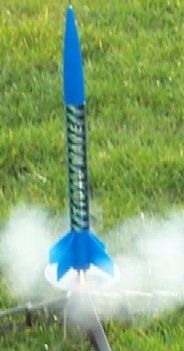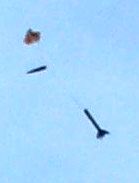| Construction Rating: | starstarstarstarstar |
| Flight Rating: | starstarstarstarstar_border |
| Overall Rating: | starstarstarstarstar |
| Manufacturer: | Estes  |
 Brief:
Brief:
A ready to fly starter set with rocket, launch pad, controller, and two B6-4
motors. The rocket is essentially the Code Red with blue plastic & tube
sticker.
Construction:
The rocket comes almost ready to fly; all the purchaser has to do is to attach
the 12 inch parachute, which is pre-assembled. Look at the instructions before
attaching the parachute, especially if you are an Estes oldtimer like me. When
I was a teenager the parachutes were normally attached to the nosecone. For
this kit the instructions specify attaching the parachute to the shock cord 3/4
inch from the nosecone.
The fins, nose cone, and launch lug are all plastic and the rocket seems sturdy enough to handle a fair bit of abuse. Like the reviewer of the Code Red I thought the nose was a bit loose in the tube, but since the instructions make no mention of taping the nose cone, and since an inexperienced builder wouldn't know to do so, I decided not to tape the nose.
The set comes with the Electron launch controller and Porta Pad 2. The launch controller is designed with a rubber grommet in the safety key. This design requires a great deal of pressure on the key to arm the circuit - enough pressure to be uncomfortable in my hand and too much for my 8 year old to manage. Fortunately the rubber can be pulled out with a pair of pliers.
The Porta Pad comes with a two piece launch rod. I found that after getting the two pieces together the joint between the rods is a little weak and easily bent. This is something to watch out for.
Attaching the parachute to the shock cord is something anybody should be able to do in under a minute. The instructions are almost all pictures and very easily followed.
Construction Rating: 5 out of 5
 Flight:
Flight:
Motors: This kit provides estimated altitudes with the motor list. The table
is:
| Engine | Feet |
| A8-3 | 84 |
| B4-4 | 230 |
| B6-4 | 254 |
| C6-5 | 600 |
Retention: The motor is held in place by a screw-on retainer on the bottom. When installing the B6-4 engines that came with the kit I had no problems, but the fit was very tight with some A8-3 engines I had purchased. A child may have difficulty getting the retaining ring on, but the instructions do advise adult supervision. Four squares of wadding were used, as per instructions. The rocket flew straight with the B6 engines and showed no weathercocking. The flight was exactly what it should be for a first timer's rocket. When using the A8 engines some weathercocking was observed, but not a great deal.
 Recovery:
Recovery:
The descent is just about perfect. Because the rocket is constructed with
fairly sturdy plastic and the only weak point (the top of the body tube) is the
last to hit the ground the rocket can handle a fairly quick descent which
minimizes drift. My daughter's only complaint is she couldn't launch and be in
a position to try and catch the rocket, she had to choose.
The only problem with recovery was a little scorching of the parachute on one flight. Adding a fifth square of wadding to future flights eliminated the problem.
Flight Rating: 4 out of 5
Summary:
This is a great rocket for introducing somebody to the hobby, and the
appearance will appeal to anybody who likes the color blue. The rocket is easy
to prep and fly, and the rocket can be flown from a backyard using A8s and
reasonable care.
Overall Rating: 5 out of 5
Sponsored Ads
 |
 |











